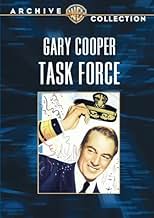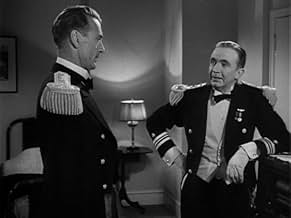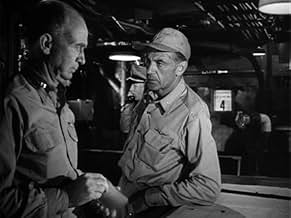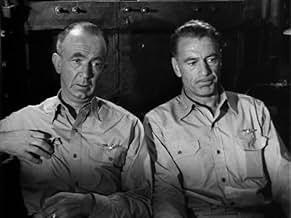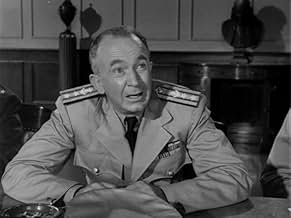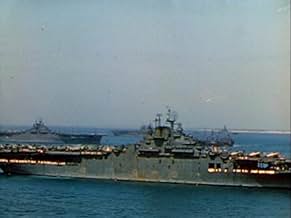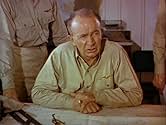IMDb RATING
6.6/10
1.3K
YOUR RATING
As he is retiring, Jonathan L. Scott "Scotty" reminisces about his long Navy career and the development of the role of the aircraft carrier from the early 20s.As he is retiring, Jonathan L. Scott "Scotty" reminisces about his long Navy career and the development of the role of the aircraft carrier from the early 20s.As he is retiring, Jonathan L. Scott "Scotty" reminisces about his long Navy career and the development of the role of the aircraft carrier from the early 20s.
- Awards
- 3 wins total
Joel Allen
- Pilot
- (uncredited)
Roger Anderson
- Pilot
- (uncredited)
Gregg Barton
- Pilot
- (uncredited)
Roscoe J. Behan
- Ames' Attache
- (uncredited)
- Director
- Writers
- All cast & crew
- Production, box office & more at IMDbPro
Featured reviews
Gary Cooper does an excellent job playing a Gary Cooper-type character. This is one of the better WWII movies to come out of the 1940s era. Jane Wyatt and Walter Brennen also do a good job. Somehow, this film always gets a lower rating than it deserves. It is somewhat dated by today's standards but gives good background of naval aviation with some very good live action combat film footage. For another good 1940s era WWII action movie with lots of good gun camera shots, see "Fighter Squadron" with Edmund O'Brien and Robert Stack.
In my opinion, the best movie ever made about the U.S. Navy in the Pacific conflict. With the pre-war black and white, and wartime, colored documentary footage adding that extra gloss to a fine film. Coop took on his role perfectly. Walter Brennan could never let you down whatever role he played. Bruce Bennet, always the reliable supporting actor. John Ridgley too. Stanley Ridges? Reliable as ever as a trouble maker. Moroni Olsen as a senior flag officer, as usual, eminence oozes out of him. And last but least, Wayne Morris; he must have felt at home in the movie, serving as he did as a carrier-based fighter pilot in the navy in the Pacific. Not being on sale in the U.K. video stores. Buyiing this video through Amazon.com was a MUST for me.
If you have Turner Classic Movies, it would behoove you to take the time to watch Task Force, a fine, passionate, and patriotic film about the advent of the aircraft carrier as the principal weapon of the US Navy in World War II. Although it is a product of the times--and the Production Code--TF delivers the story of how "flat-tops" superseded the battleship as the principal tool for, in Navyspeak, "projecting power." With the skillful use of lots of film footage (which helped tremendously in avoiding the use of cheesy ship models), TF tells the story of a young naval officer played believably here by a much older Gary Cooper. As Cooper advances in his skill as an aviator, he runs afoul of bureaucrats and bullies, both outside the navy and in. This results in his being disciplined and scolded for speaking his mind about naval aviation, and his frustration with a lack of personal advancement and the navy not being prepared for future conflict. Cooper is a lanky metaphor for the advent of the carrier as the Queen of the Seas.
With Pearl Harbor, Cooper's "Scottie" Scott is thrown into battle against an enemy that is much better prepared for air combat, and with the aid and leadership of his father figure, Walter Brennan, he (as metaphor) gains the recognition and ultimate victory he deserves.
I read somewhere that Gary Cooper surrendered his chance at ultra-stardom when he made certain decisions about parts that robbed his film persona of the sort of sex appeal that would have guaranteed his place as a film star/sex symbol. The reviewer said something about Cooper being more of a big brother than a lover.
I don't know if all this is true, but Cooper's image of being a friendly, decent, human hero is clearly seen in Task Force. He--and Brennan--carry this movie. The chemistry Coop has with his audience and his on-screen friend and C.O., Brennan, puts real blood and muscle into a movie that at times gets a bit too documentarian. Add in a sweet, loving performance by Jane Wyatt as the graceful and gracious military wife and you have a really human movie that works as history lesson, war film, political essay, and love story.
Finally, what I love about this film is its innate patriotism. There simply is no questioning of America's place and motive in the years leading up to and during the Second World War. We were a democracy threatened by tyranny. We were unprepared for war because we despised it so very much; once confronted, we prevailed. The stock footage of Cooper's carrier (in real life, the badly damaged USS Franklin) arriving at New York with her flight deck and upper hull twisted into scrap metal by Japanese explosives is startling, a metaphor for the cost of not being prepared with the sort of cutting-edge technology, training, and will that might have reduced the bloodiness of the war or prevented it all together.
With Pearl Harbor, Cooper's "Scottie" Scott is thrown into battle against an enemy that is much better prepared for air combat, and with the aid and leadership of his father figure, Walter Brennan, he (as metaphor) gains the recognition and ultimate victory he deserves.
I read somewhere that Gary Cooper surrendered his chance at ultra-stardom when he made certain decisions about parts that robbed his film persona of the sort of sex appeal that would have guaranteed his place as a film star/sex symbol. The reviewer said something about Cooper being more of a big brother than a lover.
I don't know if all this is true, but Cooper's image of being a friendly, decent, human hero is clearly seen in Task Force. He--and Brennan--carry this movie. The chemistry Coop has with his audience and his on-screen friend and C.O., Brennan, puts real blood and muscle into a movie that at times gets a bit too documentarian. Add in a sweet, loving performance by Jane Wyatt as the graceful and gracious military wife and you have a really human movie that works as history lesson, war film, political essay, and love story.
Finally, what I love about this film is its innate patriotism. There simply is no questioning of America's place and motive in the years leading up to and during the Second World War. We were a democracy threatened by tyranny. We were unprepared for war because we despised it so very much; once confronted, we prevailed. The stock footage of Cooper's carrier (in real life, the badly damaged USS Franklin) arriving at New York with her flight deck and upper hull twisted into scrap metal by Japanese explosives is startling, a metaphor for the cost of not being prepared with the sort of cutting-edge technology, training, and will that might have reduced the bloodiness of the war or prevented it all together.
Task Force was the first of two films Gary Cooper made regarding the development of aviation. Here he plays the fictional Jonathan Scott who looks back on his life after retiring from the Navy. The second is the Court Martial of Billy Mitchell where he plays the real life Army Aviation pioneer.
For today's fans if one wants to see where Tom Cruise and the gang from Top Gun all got their start, take a look at Task Force. The idea of a floating flattop ship from where airplanes could take off and land was one that was scoffed at post World War I. Pilots didn't have the skills yet for that. What Task Force shows is Gary Cooper and a whole bunch of other people who believed in an idea living and dying to prove that idea.
Task Force was memorable in the career of Gary Cooper for two other reasons. It was the first film he did after leaving his original studio, Paramount, at Warner Brothers where he worked for about five years. It was also the last film he did with good friend Walter Brennan. They made eight joint film appearances, including some memorable ones in The Westerner and Sergeant York where they got Oscars, Brennan for The Westerner and Cooper for Sergeant York.
Jane Wyatt is Cooper's leading lady, playing the part of the faithful wife where if this had been made at MGM, June Allyson would have had the part. She's the widow of one of Cooper's early Navy flier friends who is killed trying to land on a new aircraft carrier.
Director Delmar Daves made good use of actual combat footage both black and white and in the last 15 minutes color. Lent a real air of authenticity to what we were viewing. Look for some good supporting performances from Brennan, Wayne Morris, Bruce Bennett and the best being an obtuse United States Senator played by Stanley Ridges.
The final shot of the film shows Cooper now in civilian attire with jets passing overhead. That was a whole new skill that had to be learned by the next generation of Top Guns. Very graphically demonstrated in The Bridges at Toko-Ri.
I'd like to think that Tom Cruise and the rest of the cast of Top Gun saw those two films and realized the great heritage they were now going to portray.
For today's fans if one wants to see where Tom Cruise and the gang from Top Gun all got their start, take a look at Task Force. The idea of a floating flattop ship from where airplanes could take off and land was one that was scoffed at post World War I. Pilots didn't have the skills yet for that. What Task Force shows is Gary Cooper and a whole bunch of other people who believed in an idea living and dying to prove that idea.
Task Force was memorable in the career of Gary Cooper for two other reasons. It was the first film he did after leaving his original studio, Paramount, at Warner Brothers where he worked for about five years. It was also the last film he did with good friend Walter Brennan. They made eight joint film appearances, including some memorable ones in The Westerner and Sergeant York where they got Oscars, Brennan for The Westerner and Cooper for Sergeant York.
Jane Wyatt is Cooper's leading lady, playing the part of the faithful wife where if this had been made at MGM, June Allyson would have had the part. She's the widow of one of Cooper's early Navy flier friends who is killed trying to land on a new aircraft carrier.
Director Delmar Daves made good use of actual combat footage both black and white and in the last 15 minutes color. Lent a real air of authenticity to what we were viewing. Look for some good supporting performances from Brennan, Wayne Morris, Bruce Bennett and the best being an obtuse United States Senator played by Stanley Ridges.
The final shot of the film shows Cooper now in civilian attire with jets passing overhead. That was a whole new skill that had to be learned by the next generation of Top Guns. Very graphically demonstrated in The Bridges at Toko-Ri.
I'd like to think that Tom Cruise and the rest of the cast of Top Gun saw those two films and realized the great heritage they were now going to portray.
Gary Cooper plays a navy man that was one of the first pilots trained to fly from an aircraft carrier (the USS Langley) and continues his career through WWII until his retirement. The first section of the film focuses a lot on Cooper and his relationships with friends, his future wife and the navy brass.
Later, when WWII arrives, the film is much more of an action flick and gives a very competent overview of the war in the Pacific. While this did employ a lot of stock footage, it was unusual in that most all of the footage was used correctly. Unlike the ridiculously historically inaccurate film, MIDWAY (1976), TASK FORCE made sure to use clips that were accurate--featuring the correct model planes for each segment of the war (whereas in MIDWAY, they often showed planes that weren't even in the naval arsenal until well after the battle as well as had dive bombers magically turn into fighter planes in mid-flight due to horrid editing blunders).
This film really has widely different appeal depending on your perspective. If you are a history teacher and airplane nut like me, then it earns a 9 because it does a really good job of conveying the history of the American aircraft carriers from its inception in the early 1920s through WWII. However, if you are not, then you might find the film a bit cold (as it often focuses more on events than people towards the middle to the end of the film) and it might seem a bit confusing if you aren't familiar with the history of these great ships.
Later, when WWII arrives, the film is much more of an action flick and gives a very competent overview of the war in the Pacific. While this did employ a lot of stock footage, it was unusual in that most all of the footage was used correctly. Unlike the ridiculously historically inaccurate film, MIDWAY (1976), TASK FORCE made sure to use clips that were accurate--featuring the correct model planes for each segment of the war (whereas in MIDWAY, they often showed planes that weren't even in the naval arsenal until well after the battle as well as had dive bombers magically turn into fighter planes in mid-flight due to horrid editing blunders).
This film really has widely different appeal depending on your perspective. If you are a history teacher and airplane nut like me, then it earns a 9 because it does a really good job of conveying the history of the American aircraft carriers from its inception in the early 1920s through WWII. However, if you are not, then you might find the film a bit cold (as it often focuses more on events than people towards the middle to the end of the film) and it might seem a bit confusing if you aren't familiar with the history of these great ships.
Did you know
- TriviaWayne Morris who portrayed Lt.McKinney was the only actor in the cast who had actual combat experience as a carrier pilot in WWII. As a fighter pilot, Morris shot down seven enemy planes and contributed to the sinking of five enemy ships. He was awarded four Distinguished Flying Crosses and two Air Medals. He was the only combat "ace" of all the Hollywood actors who went to war.
- GoofsDuring the attack sequence on the Japanese carriers at Midway, the film shows the dive bombers striking first. Actually, it was the torpedo bombers that attacked first. This was caused by missed communications between the torpedo planes and the fighter cover. It was supposed to be a coordinated high-low attack. Almost every torpedo plane was shot down. No torpedoes made hits. While a tragic accident, the torpedo planes drew the Japanese fighter cover down to wave top height. When the U.S. fighters and dive bombers arrived there were very few Japanese fighters to intercept them.
- Quotes
Pete Richard: The disarmament conference is over. They've sunk the fleet. The Missouri, the South Dakota, the Maine, the Virginia, Nebraska Georgia. 30 capital ships. More ships sunk with the stroke of a pen than have been sunk in our entire history.
- ConnectionsEdited from Pearl Harbour (1943)
- SoundtracksTea for Two
(uncredited)
Music by Vincent Youmans
Played when Cmdr. Richard introduces Lt. Scott to the Admiral and his wife
- How long is Task Force?Powered by Alexa
Details
- Release date
- Country of origin
- Language
- Also known as
- El horizonte en llamas
- Filming locations
- Production company
- See more company credits at IMDbPro
- Runtime1 hour 56 minutes
- Color
- Aspect ratio
- 1.37 : 1
Contribute to this page
Suggest an edit or add missing content



